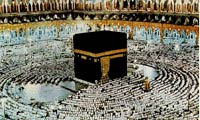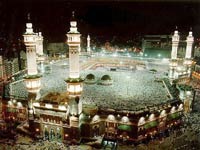|
|
 |
| Home
> Article
> Hajj (Pilgrimage)
|
| |
| Hajj (Pilgrimage)
|
| |
 |
| |
Hajj is the fifth principle of Islam.
A Muslim is required to go on a pilgrimage (hajj)
to Mecca (Saudi Arabia),
at least once in a lifetime, if the circumstances
permit. Hajj is obligatory only when an individual
is in a position, both physically and materially,
to undertake the journey to Mecca.
Before arriving in the holy city, Muslims enter
a state of consecration known as ihram, by removing
their clothes and put on the humble garment of pilgrims;
two seamless white sheets for men, and simple white
dresses and scarves for women. The white garments
are symbolic of human equality, purity, and unity
before God, since all the pilgrims are dressed similarly.
 Upon arriving in Mecca, pilgrims perform the initial
tawaf, which is a circular, counter-clockwise procession
around Ka'bah. All the while, the pilgrims state
"Labbayka Allahumma Labbayk,"
which means "Here I am
at your service, God, here I am". Tawaf
is meant to awaken each Muslim's consciousness that
God is the center of their reality and the source
of all meaning in life.
Upon arriving in Mecca, pilgrims perform the initial
tawaf, which is a circular, counter-clockwise procession
around Ka'bah. All the while, the pilgrims state
"Labbayka Allahumma Labbayk,"
which means "Here I am
at your service, God, here I am". Tawaf
is meant to awaken each Muslim's consciousness that
God is the center of their reality and the source
of all meaning in life.
Pilgrims also perform sa'i, which is hurrying 7
times from Safa to Marwah back and forth, reenacting
Hajar's desperate search for water and food.
Then, on the first official day of Hajj (8th
of Dzulhijjah), the pilgrims travel a few
miles to the plain of Mina and camp there. From
Mina, the pilgrims travel the next morning to the
plain of Arafat where they spend the entire day
in solemn prayer and devotion. That evening, the
pilgrims travel and camp at Muzdalifa, a site between
Mina and Arafat. The pilgrims stay overnight and
offer various prayers there.
 The
pilgrims return to Mina on the 10th
of Dzulhijjah, and throw seven pebbles at 3 stone
pillars that represent the devils. This symbolizes
Ibrahim's throwing stones at devil when he tried
to dissuade Ibrahim from sacrificing his son. Then
the pilgrims sacrifice animals (sheep,
lambs, cows, camels) reenacting the story
of Ibrahim’s sacrifice. The meat is distributed
to the poor and needy people. After the sacrifice,
the pilgrims return to Mecca to end the formal rites
of Hajj by performing a final tawaf and sa'i. The
pilgrims return to Mina on the 10th
of Dzulhijjah, and throw seven pebbles at 3 stone
pillars that represent the devils. This symbolizes
Ibrahim's throwing stones at devil when he tried
to dissuade Ibrahim from sacrificing his son. Then
the pilgrims sacrifice animals (sheep,
lambs, cows, camels) reenacting the story
of Ibrahim’s sacrifice. The meat is distributed
to the poor and needy people. After the sacrifice,
the pilgrims return to Mecca to end the formal rites
of Hajj by performing a final tawaf and sa'i.
Hajj is intended to develop God consciousness and
to strengthen sense of spiritual. It is also believed
to be an opportunity to seek forgiveness of sins
accumulated throughout life. Prophet Muhammad had
said that a person who performs Hajj properly "will
return as a newly born baby (free
of all sins)."
Hajj also enables Muslims from all over the world,
of different colors, languages, races, and ethnicities,
to come together in a spirit of universal brotherhood
and sisterhood to worship ALLAH together. |
| |
| Back
to other articles |
| |
|
 |
|
|
